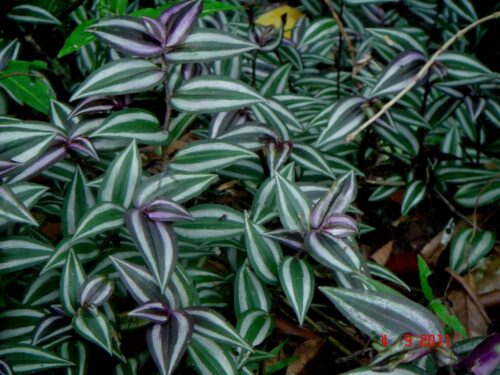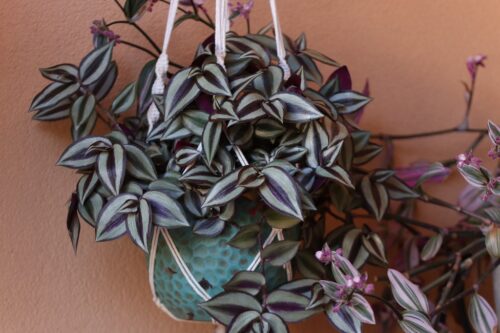Plants have long carried symbolic meaning in a variety of civilizations and religious systems, often symbolizing deep ideas and teachings. The Wandering Jew plant is one such plant with interesting symbolism that has attracted the attention of many due to its relationship with a figure from Christian mythology. We shall dig into the intriguing world of the Wandering Jew plant in this post, looking at its symbolic meaning, historical associations, and deeper implications.
The Symbolism of the Wandering Jew Plant
The Wandering Jew plant symbolizes endurance, immortality, and the soul’s journey, concepts that go beyond its roots in Christian myth. It has a special position in horticulture because of its versatility and propensity to spread. While acknowledging the rich symbolism associated with this plant, it is important to keep in mind its historical setting and steer clear of spreading false information. Instead, let’s celebrate nature’s tenacity and take heart from the resilient character of the Wandering Jew plant.
The biological relevance of Wandering Jew plants extends beyond the legend and dispute. Since they exhibit a variety of characteristics, including effective antioxidants, antibacterial agents, acetylcholinesterase inhibitors, antiarrhythmic elements, and insecticidal qualities, they have attracted interest for their possible health benefits. Due to their therapeutic potential, these traits have made them valuable additions to conventional medical systems.
Wandering Jew plants are still a topic of curiosity for scientists and herbalists alike, and research into their possible medical uses is continuing.
The story of the Wandering Jew has had a profound influence on theological and cultural debate. It acts as a sobering and contemplative reminder of the effects of one’s actions and the value of empathy and compassion. The character’s endless journey has been interpreted in many ways throughout history and across cultures, but its central message—a reminder of the human predicament and the search for spiritual salvation—remains powerful.
As an Amazon Associate we earn from qualifying purchases.
Table of Contents
Although the tale of the Wandering Jew first appeared in medieval Europe, it has developed into a complex symbol that is still relevant in modern culture. We find ourselves thinking about the ageless themes of human compassion, the consequences of our deeds, and the never-ending need for atonement as we dive into the everlasting secrets of this fabled figure.
The story of the Wandering Jew serves as a profound reflection on the human journey—a path filled with wanderings, discoveries, and the quest of a greater truth—in a world that often feels fast-paced and harsh. The tale of this everlasting guy teaches us to be careful with our decisions and deeds since they determine our futures and the routes we take.
The Wandering Jew plant is essential to maintaining biodiversity in its native environment. It acts as a ground cover plant, giving numerous little insects, birds, and animals a home and food source. It is a crucial part of several ecosystems because of how rapidly it can reproduce and how it helps to stabilize soil and prevent erosion.
However, because of the Wandering Jew plant’s widespread use in horticulture, some people are worried that it could spread aggressively in certain areas. When introduced to non-native habitats, the plant may quickly proliferate and outcompete local species, resulting in a decrease in biodiversity. Gardeners and horticulturists must be aware of this problem and take action to stop the plant from escaping into the wild.

Legends behind Wandering Jew
The Wandering Jew is a character who is destined to roam the world until Jesus’ second coming in the Christian mythology that gave rise to the name of the plant. The tradition has it that this man met Jesus on the way to the cross and either rebuked or hit him. As a consequence, he received the punishment of eternal wandering and restlessness till the end of the world.
Numerous literary and artistic works have drawn inspiration from the narrative of the Wandering Jew, with varied interpretations throughout the years. The Wandering Jew is a figure that appears in certain works as a representation of humanity’s ability to rise beyond faith in God, Christianity, or the need for divine pardon. This idea expresses the need for independence and for perseverance in the face of difficulty.
Wandering Jew : A Symbol of Eternity and Perseverance
The Wandering Jew plant’s symbolism emphasizes qualities like eternity and endurance in line with the ideas of the fable. This plant has a remarkable capacity for adaptability and growth in even the most difficult situations. The Wandering Jew plant represents resiliency, withstanding varied circumstances and spreading readily, much like the legend’s wandering figure.
According to certain spiritual traditions, the journey of the Wandering Jew plant resembles the journey of the soul through life and the afterlife. It acts as a reminder of life’s cycles and its continuation beyond the bounds of the mortal realm. The plant is associated with concepts of rebirth, rejuvenation, and the never-ending cycle of life and death thanks to this belief.
Wandering jew plant in Feng Shui
According to feng shui theory, the Wandering Jew plant promotes harmony in its surrounds. Placing the plant in a high location enables its aura to diffuse good energy into the surrounding area. It is believed that the Wandering Jew’s brilliant green leaves improve chi (energy) flow and foster harmony and serenity.
Dissecting the Anti-Semitic Origins
While the Wandering Jew plant itself holds profound and significant symbolic value, it is crucial to confront the term’s anti-Semitic roots. During the Christian era of medieval Europe, the tale of the Wandering Jew first appeared. Unfortunately, the depiction of the figure and subsequent usage of the phrase have helped to reinforce negative preconceptions and prejudices towards Jews.
The term’s offensiveness as well as its historical connotations have recently come to more people’s attention. It is essential to disassociate the plant’s symbolism from its troubling history and to recognize its importance without supporting false myths.
The Wandering Jew Plant in Agriculture
From a horticultural standpoint, gardeners and fans of indoor plants often choose the Wandering Jew plant. Its scientific name, Tradescantia, pays tribute to eminent 17th-century botanist John Tradescant. However, the plant’s popular name, Wandering Jew, refers to how quickly it spreads over gardens and other environments.
The Wandering Jew plant is a fantastic addition to both indoor and outdoor environments since it requires little maintenance. It thrives in soil that drains well and needs just moderate irrigation and shade. It contributes to air filtration and brings a touch of natural beauty to homes and workplaces as an indoor plant.
In Conclusion, The Wandering Jew plant symbolizes endurance, immortality, and the soul’s journey, concepts that go beyond its roots in Christian myth. It has a special position in horticulture because of its versatility and propensity to spread. While acknowledging the rich symbolism associated with this plant, it is important to keep in mind its historical setting and steer clear of spreading false information. Instead, let’s celebrate nature’s tenacity and take heart from the resilient character of the Wandering Jew plant.
Tradescantia symbolism
In some cultures, Tradescantia plants are seen as symbols of longevity, good luck, and prosperity. They are associated with imagination and creativity. Many people see the plant’s trailing tendrils as a representation of flexibility and adaptation.

Here are more symbolism of tradescantia:
- Tradescantia has traditionally been connected with both immortality and a happy view on life. Its adaptable character, which allows it to flourish in a variety of environments, represents the capacity to overcome difficulties and go on. People see the plant as a lucky charm and a sign of good fortune since they think it has an optimistic spirit.
- The Language of Flowers associates the Tradescantia plant with temporary pleasure due to its brief flowers, which only blossom for a single day. It acts as a reminder to treasure the transient pleasures of life and to recognize the beauty of the current moment.
- Tradescantia has been associated with moral authority and sturdiness in historical and cultural settings. Its capacity for adaptability and endurance across time conveys the idea of moral force and strength.
- The legend of the wandering jew dates back to the Middle Ages, when Tradescantia was known as “the Wandering Jew.” The Wandering Jew is a literary figure that emphasizes human progress and perseverance by standing in for humanity’s need for divine intervention or pardon.
- thankfulness & Thankfulness: The link of Tradescantia with thankfulness adds another layer to its significance. Particularly the Maranta species is often offered as a “thank you” gift, giving it a sign of respect and acknowledgment.
How to Take Care of a Wandering Jew Plant
It’s crucial to give your Wandering Jew plant the proper care if you want it to grow. The following advice will help you maintain your plant strong and healthy:
- The Wandering Jew plant likes direct, bright light. Avoid placing it in direct sunlight since it can burn the foliage.
- Watering: Ensure that the soil is continuously wet but not soggy. Before watering again, let the top inch of soil to dry off.
- The ideal indoor temperature for the plant is between 18°C and 24°C (65°F and 75°F). Steer clear of chilly drafts and abrupt temperature swings.
- Humidity: The Wandering Jew plant thrives under greater amounts of humidity. A tray of water or a room humidifier may help raise the humidity in the area where the plant is.
- Pruning: To promote bushier, healthier foliage, regularly prune back lanky growth.
- Cuttings are an easy way to multiply the plant. Simple steps include cutting a good stem, removing the bottom leaves, and planting it in a container with wet soil.
- Fertilizer: To encourage wholesome development, feed your Wandering Jew plant with a balanced liquid fertilizer throughout the growing season (spring and summer).
© 2024 Lotusmagus.com. All rights reserved. This content is protected by copyright. Visit Lotusmagus.com for more information.

